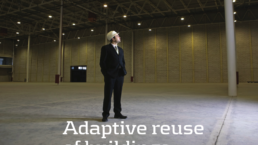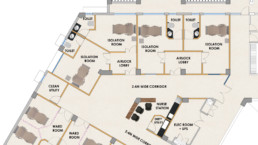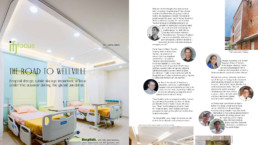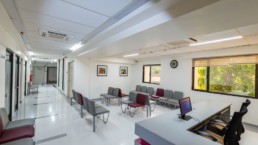Healthcare Radius in its 7th Anniversary Special issue in October 2019, featured a “power list of architects shattering archaic concepts of designs and re-shaping healthcare buildings“. Below is an article on Kshititi Nagarkar, Principal Architect, Shree Designs
Kshititi Nagarkar
Principal Architect, Shree Designs
Professional qualification: M Arch from JJ College of Architecture, Mumbai.
Location: Mumbai

Company background: For decades, Kshititi had nurtured the dream of contributing to India’s Vision 2020 in which healthcare sector was predicted to grow in an exponential manner. While she was pursuing Masters Programme at JJ College of Architecture, she chose ‘healthcare’ as her specialisation and dreamt of establishing her own practice, someday. Shree Designs was born in August 2009. “The name ‘Shree’ is in the honour of my father, my guiding star,” says Kshititi.
Contribution of healthcare architects in creating a healing environment: Healthcare architects have been instrumental in designing facilities which satisfy the needs of all stakeholders. Keeping a patient-centric focus, they are able to create a sterile workflow pattern for the doctors and an efficient work environment for the care-givers. “The bar has been raised on aspects like infection control within the facility, by focusing on indoor air quality and use of healthcare grade materials,” says she.
Healthcare projects that you have worked on: Shree Designs has marked its presence across many cities, successfully delivering over 20 projects of varying footprints. Prominent among these are:
- Multi-Speciality Facilities: Ranka Hospital, Upasani Hospital – USSH, MITR Hospital, JK Women’s Hospital, Baromaa Hospital.
- Eye Hospitals: Ramakrishna Netralaya, AEHI, Laxmi Charitable Trust Eye Hospital, Laxmi Eye Clinic
- Turnkey Healthcare Projects: Soft Touch Dental Clinic, Shaishav Paediatric Clinic, The Children’s Clinic, Gokul Diagnostic Centre, Vein Centre.
Challenges to doing healthcare projects, as against other industries? What is most important, according to Kshititi, is the proper juxta-positioning of the healthcare spaces in terms of function to achieve operational efficiencies. Stylised planning can ruin the work efficiency of medical staff and cause unnecessary delays to treatment. “Healthcare follows the dictum – form follows function. That being said, patients dread the stark and stoic spaces which are often done in the garb of sanitation and sterility. We need to design these spaces to be less intimidating and more humane and should support healing. Hence our mantra for Shree is ‘Creating Healing Spaces,'” says she.
USPs of the projects that you were engaged with: Every project we did is unique in its own way. “One of our projects had the challenge of incorporating a new wing along with the basement and services and merging them seamlessly. The OT complex, too, was well incorporated into the existing along with well-defined work flow. We engineered the first of its kind Room-in-Room Operating for USSH project. Adaptable re-use of commercial spaces to convert them to healthcare spaces has been our forte. All our multi-speciality projects are NABH accredited with full credits for the infrastructure part,” she says.
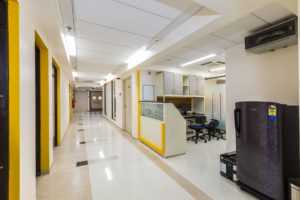
Projects in the pipeline: In the private sector, we have upcoming projects spanning from day-care set-ups to multi-speciality hospitals. We want each of our projects to have an identity of its own, hence our designs are guided by distinctive client philosophies. We believe in co-creation with our clients and consultants for a more holistic and evidence based design.
Challenges that you overcome in some of the projects: “Every project has its challenges, can’t really point to one. The challenges which we have overcome through pro activeness include the typical issues that arise with sometimes an urban site, where there’s a struggle to accommodate maximum within the minimalistic of space and with rural sites, where basic amenities like electricity and clean water supply pose challenges during the project and even after the commissioning,” says she.
How healthcare architecture has changed in the last one decade: In the last decade, healthcare design has evolved significantly with the primary emphasis on the patient satisfaction, embracing criteria of design and service from the hospitality industry. “The concept of continuing care has led to a boom in the homecare segment and seen a redundancy of departmental care like physiotherapy. The use of technology and digitisation has made it possible to use a single space for multiple functions that may have required several rooms e.g. Hybrid ORs. The focus is more on quality of care and accreditations and certifications from NABH and JCI is seeing a definite growth,” says she.

Predict some future trends in healthcare architecture: Sustainable healthcare projects would be the keystone to infrastructure planning, with promoters and hospital administrators aiming to optimise capital investment and reduce operational costs. “Flexible and adaptable space designs would be priority to enable adopting the ever changing technological advances. Pre-fab installations for interiors could be a precursor to create modular spaces which could reduce renovation time substantially. Digital connectivity would enable some departments and laboratories to shift out of the physical infrastructure to off campus locations,” she says.
Published: October 2019 | Healthcare Radius
Related Posts
Facility Planning & Designing of Upasani Super Speciality Hospital
Upasani Super Speciality Hospital (USSH) is a 60-bedded multi-speciality hospital founded by…
Adaptive Reuse of Buildings
Malls are going through a downturn as there is a decrease in the number of people spending hours in…
Isolation Rooms – The Need of the Hour
Novel Coronavirus outbreak has left healthcare practitioners as well as the common man, concerned…
The Road to Wellville – Upasani Super Speciality Hospital
The perfect blend of grandeur, ergonomics and ingenious design, integrated into a landmark…
The changing face of healthcare design
After completing a decade in designing healthcare projects, Kshititi Nagarkar, principal architect,…
Gallopers Post – Ranka Hospital, Pune
The Hospital caters to the growing demands for quality healthcare in the southern part of Pune…


